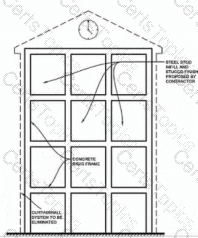During design development of a new college laboratory facility, the owner asks the architect to include way-finding signage mounted adjacent to doors. The type of signage requested will project into the corridors of the building.
Which of the following should the architect consider when selecting the signage? Check the three that apply.
An architect has just received client approval of the Schematic Design documents for a three-story, outpatient medical clinic. The clinic is located within a mixed-use development governed by
a City-approved Planned Development (PD) document. The medical clinic design utilizes standardized departmental layouts and includes outpatient clinics, as well as treatment spaces,
administrative spaces and public/lobby spaces.
The site needs to accommodate four different vehicular traffic flows: patient traffic, staff traffic, service and delivery traffic, and emergency services traffic. In addition, a pedestrian plaza
must connect to the mixed-use development sidewalks. The plaza must provide space for bicycle parking and will serve as the future bus stop.
The site design addresses several challenges related to building orientation. The southeast facade, with excellent visibility from the highway, is the location of all service equipment. The
building entrance faces northwest, convenient to the parking but not visible from the highway.
The client believes future patient volumes will outgrow the clinic. The PD document allows for a planned Phase 2 development on the adjacent vacant site to the southwest. Phase 2 would
include a second building (2 story, 80,000 BGSF) and/or a parking deck.
Other considerations for the project include:
Protected tree requirements are defined in the PD document.
Easy pedestrian access must be provided from Sycamore Boulevard.
All required parking for the clinic must be accommodated on site.
Programmed area includes 109,450 Departmental Gross Square Feet (DGSF) / 130,184 Building Gross Square Feet (BGSF).
Exterior material percentages are dictated by the PD document and shall not exceed specific percentages for Primary and Secondary Finishes.
All service equipment needs to be screened; see PD document for restrictions.
Signage opportunities are important to the client.
Acoustical privacy is a concern of the healthcare system.
The following resources are available for your reference:
Drawings, including a perspective, plans, and exterior elevations
Building Program, including client's departmental program and detailed program for Treatment 01 (Infusion)
Exterior Material Cost Comparisons
Planned Development Document
IBC Excerpts, showing relevant code sections
ADA Excerpts, showing relevant sections from the ADA Standards for Accessible Design
During the city planning review process, the city planner discovers that two of the building elevations deviate from the building design requirements set forth in the Planned Development Document. The owner is granted a variance for only one of the non-compliant facades. The facade must face the Pedestrian Access Easement.
A new four-story apartment building is being designed on a site that has solid bedrock subsurface conditions. The client requested the lowest cost of installation, highest energy efficiency, the shortest round trip time, and minimized loss of usable building space.
Which elevator type should the architect recommend?

Refer to the exhibit (concrete rigid frame building with aluminum curtain wall system).
The drawing shows a proposed concrete rigid frame building enclosed in an aluminum curtain wall system. To save money, the contractor proposed to eliminate the curtain wall system and substitute steel stud framing, which is anchored between the columns and beams and covered with a stucco finish.
What is the most likely result of this substitution?